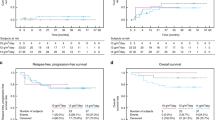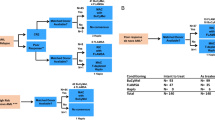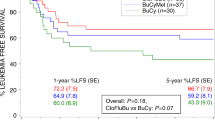Abstract
An increasing number of children with non-malignant diseases can be cured by allogeneic haematopoietic stem cell transplantation (HSCT). Treosulfan (L-treitol-1,4-bis-methanesulfonate) is being used more frequently for conditioning, owing to its’ lower toxicity profile compared with conventional myeloablative regimens. A retrospective analysis was performed of children registered in the EBMT database, who received treosulfan before HSCT between January 2005 and 2010, to identify possible dose-related toxicity and determine the incidence of engraftment, treatment-related mortality and overall survival (OS). Results from 316 transplants from 11 different countries are presented. Ninety-five (30%) were under 1 year of age at the time of transplant. OS was 83% and event-free survival was 76%; 3-year OS and event-free survival of infants below 1 year were 79% and 73%, respectively. No association was found with age at transplant, dose of treosulfan given, other agents used in combination with treosulfan, donor type, stem cell source, or second or subsequent transplant. In this report of the largest number of children to date receiving treosulfan for non-malignant diseases, treosulfan is shown to be a safe and effective agent even for those under 1 year of age at the time of transplant. Further prospective studies are needed using precisely defined protocols with pharmacokinetic monitoring and detailed chimerism analysis. In addition, long-term studies will be vital to determine long-term effects, for example, on fertility in comparison with other regimens.
This is a preview of subscription content, access via your institution
Access options
Subscribe to this journal
Receive 12 print issues and online access
$259.00 per year
only $21.58 per issue
Buy this article
- Purchase on Springer Link
- Instant access to full article PDF
Prices may be subject to local taxes which are calculated during checkout




Similar content being viewed by others
References
Sjoo F, Hassan Z, Abedi-Valugerdi M, Griskevicius L, Nilsson C, Remberger M et al. Myeloablative and immunosuppressive properties of treosulfan in mice. Exp Hematol 2006; 34: 115–121.
Ten Brink MH, Zwaveling J, Swen JJ, Bredius RG, Lankester AC, Guchelaar HJ . Personalized busulfan and treosulfan conditioning for pediatric stem cell transplantation: the role of pharmacogenetics and pharmacokinetics. Drug Discov Today 2014; 19: 1572–1586.
Beelen DW, Trenschel R, Casper J, Freund M, Hilger RA, Scheulen ME et al. Dose-escalated treosulphan in combination with cyclophosphamide as a new preparative regimen for allogeneic haematopoietic stem cell transplantation in patients with an increased risk for regimen-related complications. Bone Marrow Transplant 2005; 35: 233–241.
Casper J, Knauf W, Kiefer T, Wolff D, Steiner B, Hammer U et al. Treosulfan and fludarabine: a new toxicity-reduced conditioning regimen for allogeneic hematopoietic stem cell transplantation. Blood 2004; 103: 725–731.
Slatter MA, Rao K, Amrolia P, Flood T, Abinun M, Hambleton S et al. Treosulfan-based conditioning regimens for hematopoietic stem cell transplantation in children with primary immunodeficiency (PID): UK experience. Blood 2011; 117: 4367–4375.
Greystoke B, Bonanomi S, Carr TF, Gharib M, Khalid T, Coussons M et al. Treosulfan-containing regimens achieve high rates of engraftment associated with low transplant morbidity and mortality in children with non-malignant disease and significant co-morbidities. Br J Haematol 2008; 142: 257–262.
Glowka FK, Romanski M, Wachowiak J . High-dose treosulfan in conditioning prior to hematopoietic stem cell transplantation. Expert Opin Investig Drugs 2010; 19: 1275–1295.
Beier R, Schulz A, Honig M, Eyrich M, Schlegel PG, Holter W et al. Long-term follow-up of children conditioned with Treosulfan: German and Austrian experience. Bone Marrow Transplant 2013; 48: 491–501.
Lehmberg K, Albert MH, Beier R, Beutel K, Gruhn B, Kroger N et al. Treosulfan-based conditioning regimen for children and adolescents with hemophagocytic lymphohistiocytosis. Haematologica 2014; 99: 180–184.
Cutting R, Mirelman A, Vora A . Treosulphan as an alternative to busulphan for myeloablative conditioning in paediatric allogeneic transplantation. Br J Haematol 2008; 143: 748–751.
Boztug H, Zecca M, Sykora KW, Veys P, Lankester A, Slatter M et al. Treosulfan-based conditioning regimens for allogeneic HSCT in children with acute lymphoblastic leukaemia. Ann Hematol 2014; 94: 297–306.
Burroughs LM, Nemecek ER, Torgerson TR, Storer BE, Talano JA, Domm J et al. Treosulfan-based conditioning and hematopoietic cell transplantation for nonmalignant diseases: a prospective multicenter trial. Biol Blood Marrow Transplant 2014; 20: 1996–2003.
Nemecek ER, Guthrie KA, Sorror ML, Wood BL, Doney KC, Hilger RA et al. Conditioning with treosulfan and fludarabine followed by allogeneic hematopoietic cell transplantation for high-risk hematologic malignancies. Biol Blood Marrow Transplant 2011; 17: 341–350.
Mathews V, George B, Viswabandya A, Abraham A, Ahmed R, Ganapule A et al. Improved clinical outcomes of high risk beta thalassemia major patients undergoing a HLA matched related allogeneic stem cell transplant with a treosulfan based conditioning regimen and peripheral blood stem cell grafts. PLoS One 2013; 8: e61637.
Glucksberg H, Storb R, Fefer A, Buckner CD, Neiman PE, Clift RA et al. Clinical manifestations of graft-versus-host disease in human recipients of marrow from HL-A-matched sibling donors. Transplantation 1974; 18: 295–304.
Klein JP, Rizzo JD, Zhang MJ, Keiding N . Statistical methods for the analysis and presentation of the results of bone marrow transplants. Part I: unadjusted analysis. Bone Marrow Transplant 2001; 28: 909–915.
Klein JP, Rizzo JD, Zhang MJ, Keiding N . Statistical methods for the analysis and presentation of the results of bone marrow transplants. Part 2: Regression modeling. Bone Marrow Transplant 2001; 28: 1001–1011.
Fine JG, Gray R. J . A proportional hazards model for the subdistribution of a competing risk. J Am Stat Assoc 1999; 94: 496–509.
Gray RJ . A class of k-sample tests for comparing the cumulative incidence of a competing risk. Ann Stat 1988; 16: 1141–1154.
Choudhary D, Sharma SK, Gupta N, Kharya G, Pavecha P, Handoo A et al. Treosulfan-thiotepa-fludarabine-based conditioning regimen for allogeneic transplantation in patients with thalassemia major: a single-center experience from north India. Biol Blood Marrow Transplant 2013; 19: 492–495.
Bernardo ME, Piras E, Vacca A, Giorgiani G, Zecca M, Bertaina A et al. Allogeneic hematopoietic stem cell transplantation in thalassemia major: results of a reduced-toxicity conditioning regimen based on the use of treosulfan. Blood 2012; 120: 473–476.
Gennery AR, Slatter MA, Grandin L, Taupin P, Cant AJ, Veys P et al. Transplantation of hematopoietic stem cells and long-term survival for primary immunodeficiencies in Europe: entering a new century, do we do better? J Allergy Clin Immunol 2010; 126: 602–610.e1-11.
Romanski M, Tezyk A, Zaba C, Glowka FK . Rapid and sensitive liquid chromatography-tandem mass spectrometry method for determination of protein-free pro-drug treosulfan and its biologically active monoepoxy-transformer in plasma and brain tissue. Talanta 2014; 127: 123–132.
Ten Brink MH, Ackaert O, Zwaveling J, Bredius RG, Smiers FJ, den Hartigh J et al. Pharmacokinetics of treosulfan in pediatric patients undergoing hematopoietic stem cell transplantation. Ther Drug Monit 2014; 36: 465–472.
Gungor T, Teira P, Slatter M, Stussi G, Stepensky P, Moshous D et al. Reduced-intensity conditioning and HLA-matched haemopoietic stem-cell transplantation in patients with chronic granulomatous disease: a prospective multicentre study. Lancet 2014; 383: 436–448.
Acknowledgements
We thank Arnaud Dalassier for data correction and management.
Author contributions
CP and UP designed the study. MS, HB, AL, PV, ARG, UP and CP contributed equally to this manuscript. KWS and PS contributed to the study and manuscript. EG provided additional statistical support.
Author information
Authors and Affiliations
Consortia
Corresponding author
Ethics declarations
Competing interests
The EBMT received an unrestricted grant for the retrospective data collection and analysis from medac GmbH. CP received travel grants and study support from medac. MS received travel grants from medac. All other authors declare no conflict of interest.
Additional information
Supplementary Information accompanies this paper on Bone Marrow Transplantation website
Rights and permissions
About this article
Cite this article
Slatter, M., Boztug, H., Pötschger, U. et al. Treosulfan-based conditioning regimens for allogeneic haematopoietic stem cell transplantation in children with non-malignant diseases. Bone Marrow Transplant 50, 1536–1541 (2015). https://doi.org/10.1038/bmt.2015.171
Received:
Revised:
Accepted:
Published:
Issue Date:
DOI: https://doi.org/10.1038/bmt.2015.171
This article is cited by
-
Treosulfan vs busulfan conditioning for allogeneic bmt in children with nonmalignant disease: a randomized phase 2 trial
Bone Marrow Transplantation (2024)
-
Busulfan–fludarabine- or treosulfan–fludarabine-based myeloablative conditioning for children with thalassemia major
Annals of Hematology (2022)
-
Comparative study of treosulfan plus Fludarabine (FT14) with busulfan plus Fludarabine (FB4) for acute myeloid leukemia in first or second complete remission: An analysis from the European Society for Blood and Marrow Transplantation (EBMT) Acute Leukemia Working Party (ALWP)
Bone Marrow Transplantation (2022)
-
EBMT/ESID inborn errors working party guidelines for hematopoietic stem cell transplantation for inborn errors of immunity
Bone Marrow Transplantation (2021)
-
Lineage-Specific Chimerism and Outcome After Hematopoietic Stem Cell Transplantation for DOCK8 Deficiency
Journal of Clinical Immunology (2021)



